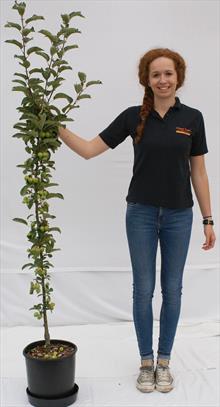Golden Hornet
Malus x zumiGolden Hornet is a traditional and popular crab-apple, which features a profusion of pink-white blossom in spring. In autumn it produces a mass of small yellow fruit which will stay on the tree until late in the year providing a useful colour feature in the garden.
The leaves also turn an attractive yellow colour in autumn.
The fruits are useful in the kitchen, for crab-apple jelly and a good source of pectin for jam-making. The fruits are quite persistent (they hang on the tree for a period) but if you are intending to use them in the kitchen, be sure to pick them before they start to drop.
Golden Hornet is an excellent pollinator for most apple varieties, particularly late-flowering varieties (flowering groups 4 and 5), as it produces a lot of blossom over a long period. It is a common sight at the end of rows of apple trees in commercial orchards.
Golden Hornet crab-apple trees for sale

All our pot-grown trees are grown for us to our specification by the Frank P Matthews nursery.
All pot-grown trees are suitable for planting out in the garden, some are suitable for growing in containers.
11-year bare-root
tree
£36.75
Medium size (2.5m-3.5m after 10 years)
Out of stock
Sorry we have sold out for this season
22-year pot-grown
tree
£61.00
Grown for us by Frank P Matthews nursery
In a 12L pot
Medium size (2.5m-3.5m after 10 years)
Next deliveries
Order now for delivery from 24th April.
How to grow
Golden Hornet can be somewhat prone to leaf-scab in wetter climates. It is also susceptible to fireblight, although this is not an issue for UK growers.
It can also have a tendency to grow in a straggly fashion, although this is a minor inconvenience and does not detract from its usefulness for crab-apple jelly or as a pollinator of other late-flowering apple trees.
History
Golden Hornet was raised by John Waterer and Sons nursery, and introduced in 1948. It is believed to be a seedling of two other crab-apple species, Malus sieboldii calocarpa and Malus prunifolia coccinea.
In 2013 Golden Hornet lost its RHS AGM award, which was subsequently given to another yellow-fruited crab-apple, Comtesse de Paris, which has a better growth habit. However Golden Hornet remains in most respects an excellent choice if you want a persistent yellow-fruited crab-apple which is good in the kitchen. The fruits are arguably more attractive than those of Comtesse de Paris.
Golden Hornet characteristics
- Gardening skillAverage
- AwardsRHS AGM (former) - 1999
- Attractive featuresAttractive flowersAttractive fruit
- Growth habitUpright-spreading / Vase - Can grow in a somewhat ungainly fashion.
- Height after 10 years3m-5m / 10ft-16ft
- SunlightPrefers full sun
- Growth rateAverage
- Flower colourWhite
- Leaf colourGreen
- Fruit colourYellow
- Fruit persistencePersistent
- Food usesJam / Jelly
- Country of originUnited Kingdom
- Annual cycleDeciduous
Similar varieties
MalusComtesse de ParisAnother yellow-fruited crab-apple, with somewhat better scab resistance.
What will it look like?
Illustrative example of a pot-grown tree of this variety as supplied.
Approximate girth: 6/8cm. We try to keep all pot-grown trees down to about 1.5m as supplied, but some may be larger.
Trees should reach their mature height after about 10 or more years.
We may also have 1-year bare-root trees of this variety - they are not shown here.

How to choose a crab-apple tree
We list more than 40 different crab-apple trees. Choosing can be difficult! See our article explaining the different characteristics of crab-apple trees which will help you narrow down the selection.
 Over 400 varieties of flowering cherries, crab apples, rowans and other ornamental trees.
Over 400 varieties of flowering cherries, crab apples, rowans and other ornamental trees.